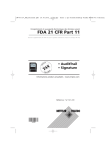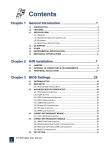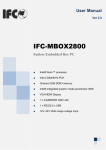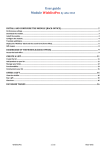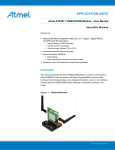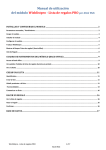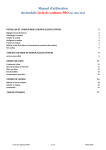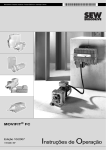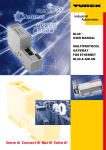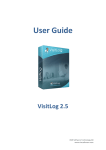Download User manual
Transcript
User manual Product description Controller PSC 3 3791133000_02 Table of contents 1 2 3 4 5 6 About the Delta PSC 3 controller ....................................................................... 2 Features overview .............................................................................................. 4 Functional overview ............................................................................................ 5 3.1 Battery functions ...................................................................................... 5 3.2 Source string function .............................................................................. 5 3.3 Rectifier functions..................................................................................... 6 3.4 Signal processing engine ......................................................................... 6 3.5 AC measurement function........................................................................ 6 User interfaces ................................................................................................... 7 4.1 Web user interface ................................................................................... 7 4.1.1 Web user interface menu........................................................... 8 4.2 Local user interfaces .............................................................................. 12 Physical connections ........................................................................................ 13 Modules ............................................................................................................ 14 6.1 User Interface Module UIM1 .................................................................. 14 6.2 String Sensor Module SSM .................................................................... 15 6.3 Block Voltage Sensor Module BSM ....................................................... 16 6.4 Remote Alarm Board IOM-ALARM ........................................................ 17 6.5 LED Driver Board IOM-LED ................................................................... 18 6.6 Input/Output Module IOM-AC................................................................. 19 6.7 Healthy Phase Selector HPS ................................................................. 20 6.8 AC Measurement Gateway Module ACM1 ............................................ 21 6.9 Gateway Module GWM-MODBUS ......................................................... 22 6.10 CAN Repeater Module IMBUSR1 .......................................................... 23 6.11 CAN Isolation Module CAN-ISO ............................................................ 24 6.12 Generator Control Module GEN ............................................................. 25 6.13 Static Voltage Regulator Module SVR ................................................... 26 6.14 PT100 Temperature Sensor Adaptor ..................................................... 27 6.15 Fan Speed Controller PWM CTRL ......................................................... 28 6.16 SENSN device ....................................................................................... 29 Product description, Controller PSC 3 Table of contents 1 About the Delta PSC 3 controller This document has been created for PSC 3 software version 2.6x. The document is updated only when necessary when new software versions are released. PSC 3 is a sophisticated power system controller that can be used for both small and very large, complex power systems. It consists of a single central unit, which provides basic I/O periphery. A very robust and reliable CAN standard-based communication bus (IMBUS) provides easy expansion. PSC 3 uses external modules for monitoring system elements. This modular approach is perfect for expandable power systems with decentralized distributions (BDFB) and batteries in separate rooms. The integrated PLC offers the flexibility for monitoring and control of auxiliary devices, system upgrades, and capacity expansions. The enhanced system functions provided by PSC 3 help reduce operating costs and improve availability. Battery management, for example, is one of the key factors for the availability of a power system. Regular capacity tests by PSC 3 significantly improve battery management. PSC 3 also allows remote alarms by means of potential-free relay contacts, modem, or LAN/Ethernet or via SMS. The SNMP functionality offers enhanced remote alarms working with SNMP managers. The alarms are classified as critical, urgent or non-urgent alarms. An integrated web server offers a user-friendly graphical interface for detailed monitoring and control using a web browser. The PSC 3 can be accessed from virtually anywhere, over intranet or Internet, or by modem. The user interfaces can be localized, supporting up to two additional languages besides English. 2 Product description, Controller PSC 3 About the Delta PSC 3 controller Figure 1. PSC 3, the heart of a modular power system Product description, Controller PSC 3 About the Delta PSC 3 controller 3 2 Features overview The key features of a PSC 3 system include: • • • • • Modular concept: PSC 3 can be customized for both small and large systems Flexible setup and supervision of battery-, source- and load strings Remote system supervision over intranet, Internet and modem Remote software update of system components AC mains voltage measuring without external equipment PSC 3 offers the following features: • Local system monitoring and basic setup with display, keypad and 5 alarm LEDs • Flexible event processing for alarm management • 3 Alarm levels: Critical, Urgent, Non-urgent • Localization of user interface, supporting up to two additional languages • Ethernet interface to PC or LAN • Modem or RS 485 interface • 3 inputs for shunt measurement, current and fuse supervision • 4 inputs for battery middle point measuring • 2 RECTS interfaces • 2 IMBUS interfaces using CAN bus • 6 digital relay outputs (changeover contacts, pluggable clamp connection) • 4 digital open collector outputs • 4 digital inputs • 2 inputs for temperature sensors • Real time clock • LVD driver relay output • DHCP server and auto-detect of Ethernet cable type for easy connection to a computer Additional HW and/or SW components extend the range of features to include: • Expandable number of voltage measurements for battery blocks • Rectifier positioning • Expandable number of battery- / load- / source-strings (current, voltage, temperature, fuse supervision) • Expandable number of relay outputs for alarms or LVD/LVLD • Expandable number of LED outputs for alarm or status indications • Expandable number of digital inputs with individual threshold and hysteresis • 2 local user interface modules with additional buzzer (UIM) • AC measurement with external module (3-phase voltage, current, frequency, power, energy) • Genset control including measurement of AC output parameters • Static voltage regulation vie SCR drivers / multiple tap transformer • Healthy phase selector • Speed control for cooling fans of outdoor cabinets or containers • RS-485/Modbus interface to communicate with DC energy meters • SNMP for reporting events to a network supervision device • Forwarding alarms via SMS 4 Product description, Controller PSC 3 Features overview 3 Functional overview The main task of the system controller is to enhance the reliability and lower the operating and maintenance costs by: • Controlling the rectifiers to run at the highest efficiency. • Extending the battery life time by providing the best possible conditions. • Informing the user in case interventions are needed and providing the necessary information for corrective actions. 3.1 Battery functions The system controller includes the following charge functions, with or without temperature compensation: • • • • Float charge Boost charge Equalize Event controlled charge (for example, generator set usage) The test functions include: • Constant current, capacity, real load, and time based battery tests • Natural battery test (using the opportunity of a mains failure) • Separate discharge/charge of a battery The protection functions include: • Disconnection (due to low voltage or mains failure plus delay) - Battery disconnection - Full and partial load disconnection • Charging current limitation The supervision functions include: • • • • 3.2 Loss of back-up time Middle point voltage supervision String current comparison Block voltage measurement Source string function The current from solar converters and wind generators can be measured by shunts in socalled source strings and such upgrading a power plant to a RHPS (Renewable Hybrid Power System). Product description, Controller PSC 3 Functional overview 5 3.3 Rectifier functions The control functions include: • Efficiency mode – optimizes the system for efficiency, switches off unused rectifiers, and so on • Forced rectifier cycling - balancing the operation time of rectifiers The supervision functions include: • Redundancy supervision – alerts if there is no redundant rectifier • Recharge power supervision – alerts if there is not enough power to recharge battery within specified time 3.4 Signal processing engine PSC 3 has a built in Signal Processing Engine, which allows defining reactions to react to events initiated by specified parameter changes. The user may define as many events as needed on all digital inputs as well as on measurements, such as voltage, current, and temperature using signal conditioning. Events may be combined using logical functions AND, OR, Boolean inversion, signal filtering, latching events, and timer events. 3.5 AC measurement function PSC 3 measures basic mains voltages using the connected rectifiers. The measured values can be viewed via local and / or web user interface: • Phase-Neutral voltages The optional HPS module can be used to measure the parameters of the AC network: • • • • • • Phase-Neutral and Phase-Phase voltages Currents Apparent power Active power Energy Frequency With the ACM1 Gateway Module it is possible to connect a commercial 3 phases AC-measurement device, providing more AC information: • • • • • Phase-Neutral and Phase-Phase voltages Currents Active power Frequency Power factor The measured values are visible via local / web user interface, too. 6 Product description, Controller PSC 3 Functional overview 4 User interfaces 4.1 Web user interface An integrated web server provides the interface for monitoring and controlling the power system by a computer with a standard web browser. The PSC 3 Configuration and Supervision Tool offers flexible and comprehensive configuration and supervision functions for power systems. It can be operated by almost all common web browsers. Access to controller and system functions is provided with user and session management features. Figure 2. PSC 3 Configuration and Supervision Tool The Navigation Bar on the left is used to navigate through the dialogue pages: • • • • Click on „+“ to expand the desired menu. Click on „• xxxxx“ to access the desired function / window. Click on „?“ to get online help to the active window Click on „-“ to collapse the menu. Product description, Controller PSC 3 User interfaces 7 4.1.1 Web user interface menu Some dialogues are not visible in the navigation bar. These ones are accessible via other dialogues only and are marked in the following figures (*). Figure 3. Web user interface menu part 1 8 Product description, Controller PSC 3 User interfaces Figure 4. Web user interface menu part 2 Product description, Controller PSC 3 User interfaces 9 Figure 5. Web user interface menu part 3 10 Product description, Controller PSC 3 User interfaces (Configuration continued) (G8.4) System Architecture 6.37 Middle Point 6.38 Middle Point Setup* 6.44 Block Measurement Block Measurement Setup* 6.16 Battery String Setup* 11.3 LVD 11.2 LVD Setup* 6.17 Load String Bus Components (G8.5) 6.18 Load String Setup* I/O Modules (G8.7) Rectifier Type Selection* Rectifier Positioning Definition 7.5 6.14 Scheme Selection* BSM Modules 7.18 7.19 DC Source String Editor* 7.8 Sensn Bus & Address Editor* 7.9 Sensn Device Details* 7.10 GEN Parameter Setup* 6.51 PSC 3 Parameter Setup* 6.52 6.54 SVR Overview Rectifier Modules 7.3 UIM Modules 7.14 SVR Setup* 7.16 HPS Setup* 7.17 ACM Name Editor* GWM Modules 7.27 7.23 7.24 7.25 SVR Name Editor* HPS Modules 7.28 7.29 HPS Name Editor* IMBUS Module Details* 7.11 IMBUS Module SW Update* System Characteristics 6.58 7.22 GEN Name Editor* SVR Modules 6.57 HPS Mode Selection* 7.26 GWM Name Editor* GEN Modules 6.55 6.56 HPS Overview ACM Modules 6.71 6.50 Genset Overview SENSN Devices 6.19 6.70 DC Source String BSM Name Editor* 4.10 6.13 Rectifier Positioning Editor* 7.6 SSM Name Editor* 6.12 Rectifier Group Editor* 7.21 IOM Name Editor* SSM Modules 6.11 Rectifier Grouping 7.20 IOM Modules 6.45 6.15 Battery String 7.12 (G8.6) 6.8 6.6 System Parameter PSC 3 Hardware System Interface Board Hardware 6.32 Control Board Hardware 6.33 PSC 3 Software Options 6.25 Figure 6. Web user interface menu part 4 Product description, Controller PSC 3 User interfaces 11 4.2 Local user interfaces Through the local interface, essential system configuration and monitoring can be conducted. The local interface provides a 128 x 64 pixel LCD display, keypad for menu navigation, and five configurable LEDs. In most applications, UIL1 meets all demands for local control, even for very large systems. Because PSC 3 can be mounted within a secure location, it may not be readily available to access the UIL. The functions of the UIL can be repeated in a UIM module, which can be mounted in a more convenient location, such as the cabinet door panel. For more information about the UIM module, see section 6.1 "User Interface Module UIM1". Figure 7. PSC 3 front view 12 Product description, Controller PSC 3 User interfaces 5 Physical connections PSC 3 has an Ethernet connection on the front panel for connection to a computer. This connection can be either direct to the computer, or over a local area network (LAN). O U T 6 RECT O U T 5 O U T 3 O U T 4 O U T 2 Relay Relay IMBUS GND LAN UBATUSYS-, USYS+ SH1/2/3 TEMP1/2 UM IN OC Serial RECT IMBUS SENSN OUT1…6 RECT Relay 150Ω SERIAL USYS+ USYS+ USYSUBAT- Temp 1/2 USYS- O U T 1 SENSN 120O IMBUS Relay 60O IN UM Relay IMBUS LVD SH3 SH2 SH1 Relay IMBUS OC LAN A local user interface (UIL, display with keypad and 5 alarm LEDs) for monitoring and basic configuration functions is provided, see Figure 8. LAN (Ethernet) interface to PC / LAN (front) Backup power supply PSC 3 Power supply PSC 3 Inputs for shunt measurements (current measurement, fuse supervision analogue) Temperature measurements inputs 4 middle point measurement inputs 4 digital inputs Open collector digital outputs Modem or RS 485 interface (see HW variants) IMBUS connector for rectifiers (flat cable without powering) and IMBUS connector for rectifiers (6 pole RJ Teljack without powering) IMBUS connectors (with powering) Interface for shunt sensor modules 6 relay outputs 1…6 Figure 8. PSC 3 top view with connectors All peripheral connections are pluggable, using either telephone jacks or pluggable clamp connections. Product description, Controller PSC 3 Physical connections 13 6 Modules 6.1 User Interface Module UIM1 The UIM1 User Interface Module repeats the functions of the local user interface (UIL) on PSC 3. Up to two UIMs can be connected to PSC 3 through the IMBUS. The UIM provides a 132 x 64 pixel LCD display, keypad, buzzer, and five configurable LEDs. The UIM does not require configuring to use with PSC 3. Addresses are set with DIP switches internal to the UIM. The UIM is powered by the IMBUS and can be plugged into the IMBUS while the PSC 3 controller is operating. PSC 3 detects and links to the UIM. Note! For compatibility with PSC 3 software version earlier than 1.70, or for use in very large systems, UIM1 consisting of a LCD, keypad, LED indication, and a buzzer is still supported. Figure 9. User Interface Module. Front view (top)/Rear view (below) 14 Product description, Controller PSC 3 Modules 6.2 String Sensor Module SSM The SSM is a front end module, which can be used to extend the amount of peripherals in a modular manner. Up to 31 SSMs can be connected to the IMBUS. The power supply is provided from the PSC 3. The SSM provides the following functions: • • • • 3 relay outputs 4 digital inputs up to 3 SENSN modules can be connected to the SSM 1 voltage, current, temperature, or fuse monitoring per SENSN module This SSM is available as an open frame module. For DIN Rail mounting, an optional case is available. Figure 10. Open and closed frame version of the String Sensor Module (SSM) Product description, Controller PSC 3 Modules 15 6.3 Block Voltage Sensor Module BSM The BSM provides inputs for up to 12 block voltage measurement and 3 digital inputs with software selectable activation and deactivation levels. The block voltage measurements cover the range ±77 Vdc. With the addition of standard temperature sensor LM335, measurements in the range of -40 to +100 °C can be made. Figure 11. Block Voltage Module BSM ID:A1 16 Product description, Controller PSC 3 Modules 6.4 Remote Alarm Board IOM-ALARM The IOM-ALARM is a front end module, which can be used to extend the amount of peripherals in a modular manner. Up to nine IOM-ALARMs can be connected to the IMBUS. The IOM-ALARM is supplied from the 48V system bus. The IOM-ALARM provides the following functions: • 10 relay outputs The IOM-ALARM is available as an open frame module. For DIN Rail mounting an optional case is available. Figure 12. IOM-ALARM Product description, Controller PSC 3 Modules 17 6.5 LED Driver Board IOM-LED The IOM-LED is a front end module, which can be used to extend the amount of peripherals in a modular manner. Up to nine IOM-LEDs can be connected to the IMBUS. The power supply is provided from the PSC 3. The IOM-LED provides the following functions: • 20 open collector outputs to drive LEDs • 2 digital outputs This IOM-LED is available as an open frame module. For DIN Rail mounting, an optional case is available. Figure 13. IOM-LED 18 Product description, Controller PSC 3 Modules 6.6 Input/Output Module IOM-AC The IOM-AC is a front end module, which can be used to extend the amount of peripherals in a modular manner. Up to nine IOM-ACs can be connected to the IMBUS. The power supply is provided from the PSC 3. The IOM-AC provides the following functions: • 6 relay outputs to drive contactors • 2 digital inputs to detect AC voltages This IOM-AC is available as an open frame module and needs to be protected on the system level. Figure 14. IOM-AC Product description, Controller PSC 3 Modules 19 6.7 Healthy Phase Selector HPS The HPS is a front end module, which can be used to control equipment called Healthy Phase Selector which selects two best phases out of three. As this module measures AC parameters, it can be used also as AC measurement module without the Healthy Phase Selector hardware and function. The HPS provides the following functions: • Measurement of voltages, currents, frequency, power and energy • 3 relay outputs for control purpose This HPS is available as an open frame module and needs to be protected on the system level. Figure 15. Healthy Phase Selector (HPS) 20 Product description, Controller PSC 3 Modules 6.8 AC Measurement Gateway Module ACM1 The ACM1 is a gateway between the PSC 3 IMBUS and an external 3-phase AC measurement device using an RS 485 interface with MODBUS protocol. The following AC measurement devices are supported: • • • • • • KRON MULT-K Socomec DIRIS Ap Socomec DIRIS A40 General Electric MTDN3 General Electric MTDN1 Ably MGE 3 PSC 3 offers also basic AC measurements using the rectifier modules. Figure 16. ACM1 AC Measurement Gateway Module Product description, Controller PSC 3 Modules 21 6.9 Gateway Module GWM-MODBUS The GWM-MODBUS is a gateway between the PSC 3 IMBUS and an external DC energy meters using an RS 485 interface with MODBUS protocol. Up to 15 GWM-MODBUS modules can be connected to the IMBUS. The power supply is provided from the PSC 3. This GWM-MODBUS is available as an open frame module. For DIN Rail mounting, an optional case is available. Figure 17. GWM-MODBUS 22 Product description, Controller PSC 3 Modules 6.10 CAN Repeater Module IMBUSR1 The IMBUSR1 module provides repeater functions in the CAN bus. The IMBUSR1 repeats the bus signals and power supply. This enables large system with a high number of nodes to be constructed without signal loss or degrading of the power supply to the nodes. Repeater input CAN1 The repeater input CAN1 is connected to the IMBUS coming from PSC 3. There are two connectors in parallel to allow daisy chaining repeaters in large systems. Repeater output CAN2 The output of the repeater can be wired as a start point or as an end-to-end connection. For more information about wiring and bus termination, see System Installation and Commissioning Manual. Figure 18. IMBUSR1 CAN Repeater Module Product description, Controller PSC 3 Modules 23 6.11 CAN Isolation Module CAN-ISO The CAN-ISO module provides galvanic isolation in the CAN bus and can be used to interconnect CAN modules having different ground potential. The power supply is provided from the PSC 3, but the CAN modules connected to the secondary side need to be powered from elsewhere. This CAN-ISO is available as an open frame module or with sheet metal enclosure. Figure 19. CAN-ISO 24 Product description, Controller PSC 3 Modules 6.12 Generator Control Module GEN The GEN module is used to control a genset having no built-in controller. Up to two GEN modules can be connected to the IMBUS. The power supply is provided from the start battery. The HPS provides the following functions: • Start and stop control of the engine • Engine supervision: - Oil pressure - Temperature - Fuel level - Battery state • Measurement of the generator - Voltage - Current - Frequency - Power - Energy This GEN is available as an open frame module. Figure 20. GEN Product description, Controller PSC 3 Modules 25 6.13 Static Voltage Regulator Module SVR The SVR module is used to regulate 1-phase AC voltage from the variable input voltage. This works with static switch to control AC output with help of multiple tap transformer, this board has inbuilt SCR driver/sense circuits, it also includes AMF control and bypass control relay output, Input AC, output AC, Bypass AC(L-N) and transformer temperature monitoring. SCR 2 Control /Sense SCR 1 Control /Sense SCR 4 Control /Sense SCR 5 Control /Sense SCR 6 Control /Sense SCR 7 Control /Sense CND13 CND22 SCR 8 Control /Sense SCR 9 Control /Sense 1 CND18 IMBUS CND8 CND6 CND11 CND10 STATIC VOLTAGE REGULATOR (SVR) CND24 CND23 RELAY 2 LEDD1 CND19 IMBUS CND2 1 CND21 CND5 6 AMF Control CND1 CND16 1 INPUT, OUTPUT, BYPASS AC IN Bypass Control LEDD9 CND12 1 LEDD4 LEDD2 LEDD5 LEDD7 LEDD3 LEDD6 CND7 LEDD8 1 CND9 SWD2 ID ADJ CND4 CND17 1 1 RELAY 1 CND20 1 TEMP. SENSE CT INPUT AMF Sense 1 6 FAN DRIVER SCR 3 Control /Sense 2 +48V_Aux power Figure 21. Static Voltage Regulator SVR 26 Product description, Controller PSC 3 Modules 6.14 PT100 Temperature Sensor Adaptor The PT100 Temperature Sensor Adaptor provides inputs for up to four PT100 temperature sensors. The output connections allow connection to the PSC 3 controller through the IMBUS bus or through SENSN, SSM1 or BSM IDA1 modules to the PSC 3 controller. Figure 22. PT100 Temperature Sensor Adaptor Product description, Controller PSC 3 Modules 27 6.15 Fan Speed Controller PWM CTRL The PWM CTRL controls the speed of the fan by using a PWM signal. PWM CTRL is powered from 48V system bus and it is not connected to the IMBUS. The PWM CTRL provides the following functions: • Two digital inputs compatible with PSC 3 open collector outputs to select the duty ratio • Four predefined duty ratios: -0% - 40 % - 65 % - 100 % This SSM is available as an open frame module. For DIN Rail mounting, an optional case is available. Figure 23. Fan Speed Controller PWM/CTRL 28 Product description, Controller PSC 3 Modules 6.16 SENSN device The SENSN device is a front end module, which is assembled directly onto the shunt. This module monitors different strings in the power system individually. Up to 3 SENSN devices can be connected to a PSC 3 or to each string sensor module SSM. The power supply is provided from the PSC 3 or SSM. One SENSN provides the following functions: • • • • 1 string current measurement (shunt) 1 string voltage measurement 1 temperature 1 string fuse monitoring address selection Figure 24. SENSN device Product description, Controller PSC 3 Modules 29 Our InD, OutD and HelpD series are designed to complement each other. InD stands for indoor power systems, while OutD solutions are created for demanding outdoor use. HelpD is our global support team; its task is to make everything easy for you. The full range of Delta Power Systems keeps you powered and allows you to concentrate on what is most important for you – your business. www.deltapowersolutions.com *3791133000*



































